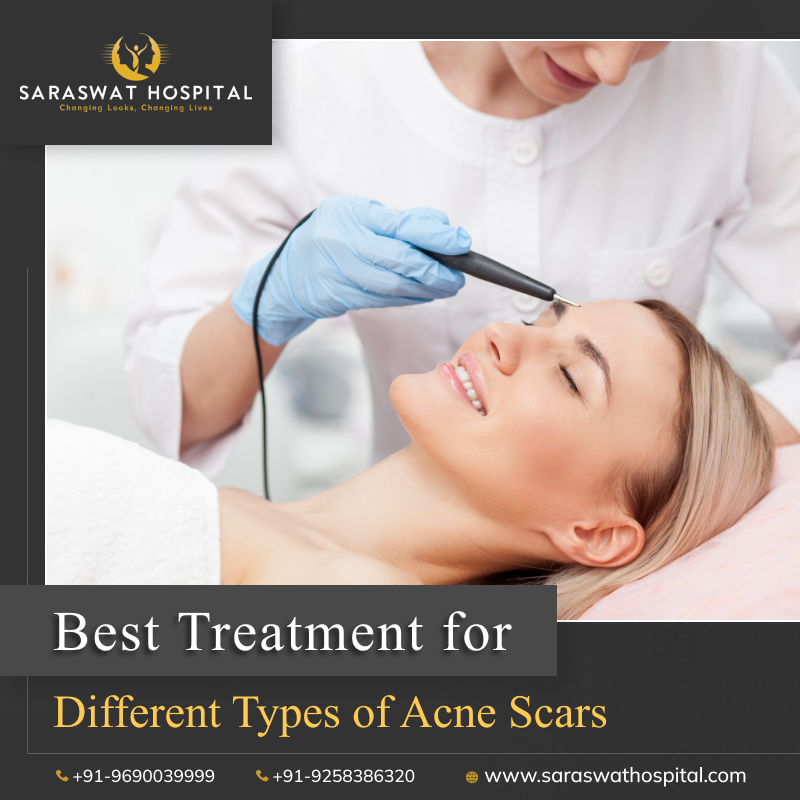Acne is a common skin problem faced by both men and women, especially seen in people with oily skin. It is more common in the adolescent years, but can be troubling in the adult years too. Acne is caused by the clogging of skin pores due to excessive oil particles, dead skin cells, and dust. This can lead to pimples, whiteheads, and blackheads on the skin.
Everyone hates going through the experience of angry red acne on their skin. But what’s even more terrible are the scars left behind by acne. Acne scars are notoriously hard to get rid of. You need to seek advanced acne scar treatment by professional experts to regain clear and smooth skin.
At Saraswat Hospital in Agra, we offer advanced treatment for all types of acne scars. Below, we look at the different types of acne scars.
Types of acne scars
The severity of acne can be graded into mild, moderate, and severe. In case of severe acne, it can cause aching pus-filled bumps, referred to as cysts or nodules, below the skin.
On the other hand, pus-filled pimples and red bumps are referred to as moderate acne. Mild acne is indicated by less irritating blackheads or whiteheads that may or may not appear with pustules or red bumps.
Usually, mild or moderate acne leaves behind brown or light red marks which disappear over time on their own. However, severe acne tends to leave a permanent scar on the skin. Moreover, permanent scar generally develops when you squeeze or pick your acne than allowing it to heal or treat it under a dermatologist’s supervision.
Atrophic scars
Atrophic scars refer to the shallow and flat depressions which heal below the uppermost layer of the skin. Scars like these are generally outcomes of severe cystic acne that are painful in nature. Nonetheless, several other kinds of acne can lead to these atrophic scars at the same time. Atrophic scars can be classified into three types:
- Ice pick scar: Ice pick scars can be identified when you observe narrow and smaller indentations pointing toward the skin surface are visible clearly. Treating this kind of scar is nothing less than a challenge. Also, they might require aggressive and persistent acne scar treatment to see positive results over time.
- Boxcar scar: Boxcar scars are identified by depressions that appear like a box with sharp edges. Generally, chickenpox, widespread acne, or varicella lead to the formation of Boxcar scars. They usually form on the jaw and lower cheek areas, where the skin is comparatively thick.
- Rolling scar: Rolling scars don’t have a fixed depth. They make the skin appear wavy and uneven because of the sloppy edges of the scars.
Hypertrophic scars
Hypertrophic scars appear as raised lumps of scar tissue in the area of the acne. This scar is formed by the building up of scar tissue that sometimes maybe the outcome of previous acne spots.
Keloid scars
Unlike hypertrophic scars, keloid scars grow inside the border of the place where the acne once was. Keloid scars generally have a smooth and firm natural overgrowth of fibrous tissue on a healed acne region.
Fractional CO2 Laser Acne Scar Treatment
The fractional CO2 laser is considered to be one of the best acne scar treatment procedures recommended by experts. In this method, laser beams are used to create small wounds on the uppermost layers of the skin. This increases the collagen production in our body to fasten the healing process. As a result, a new layer of skin is formed with visibly reduced scars and a revitalized glow.
Fractional CO2 laser treatment is a great cure for people with acne scars, dark spots, pigmentation, wrinkles, and fine lines. At Saraswat Hospital, we have AAAM-certified international experts to guide you with personalized treatments based on the severity of your acne scars.
Conclusion
Highly visible acne scars on the face can lead to self-consciousness and a lack of confidence for many people. The best way to combat such situations is by opting for advanced acne scar treatment by experienced professionals. Visit Saraswat Hospital in Agra for a personalised consult by the experts.








Leave a Reply